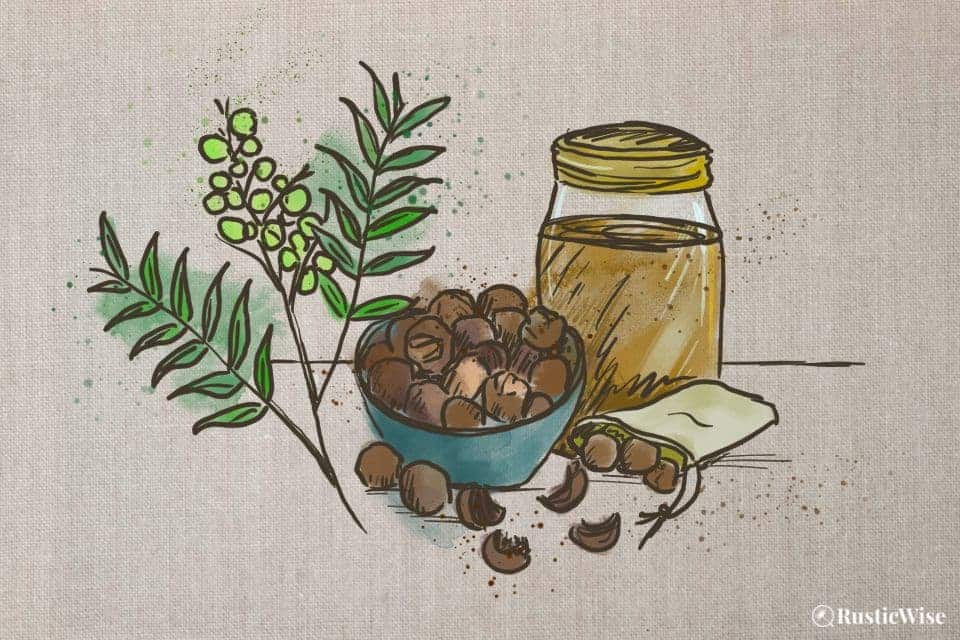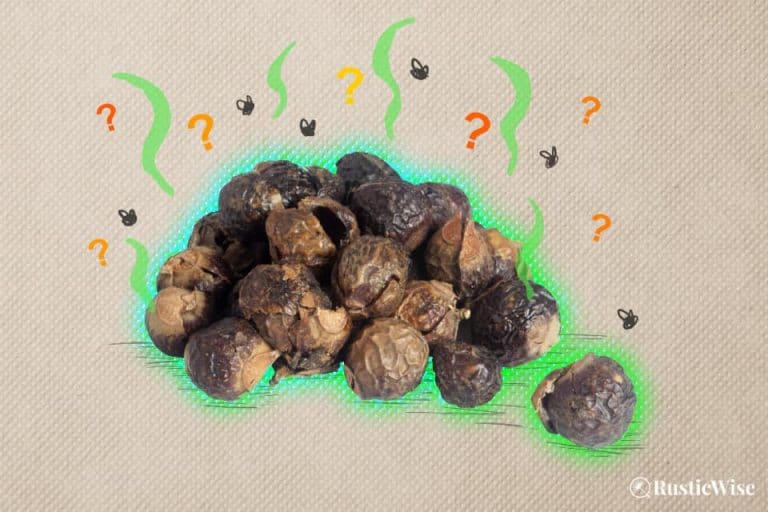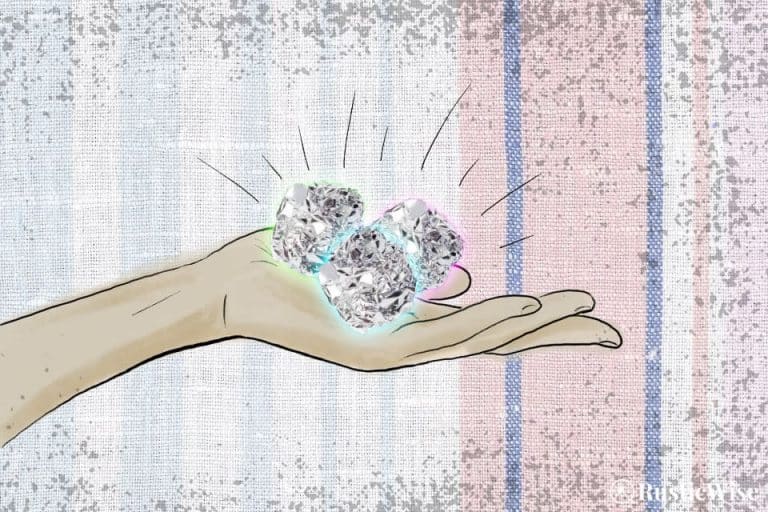What are Soapberries: 7 Benefits + 7 Ways to Use This Natural Soap
If you’re looking for a way to lower your carbon footprint and cut down on the use of chemicals, you may have encountered dried, leathery brown husks, often called soap nuts. This is a misnomer as these are actually the fruits of the soapberry tree.
So what are soapberries, exactly? Soapberries are the fruits of the soapberry tree from the genus Sapindus, which belongs to the lychee family (Sapindaceae). The shells of the fruits contain natural saponins, which act as a natural surfactant.
When mixed with water, dried soap nuts create suds and lather, making it an effective, yet eco-friendly natural soap. It’s safe for skin and hair and has a multitude of uses around the house.
We’ll take a closer look at how these lovely berries actually work, and how you can incorporate them into your personal care and household cleaning!
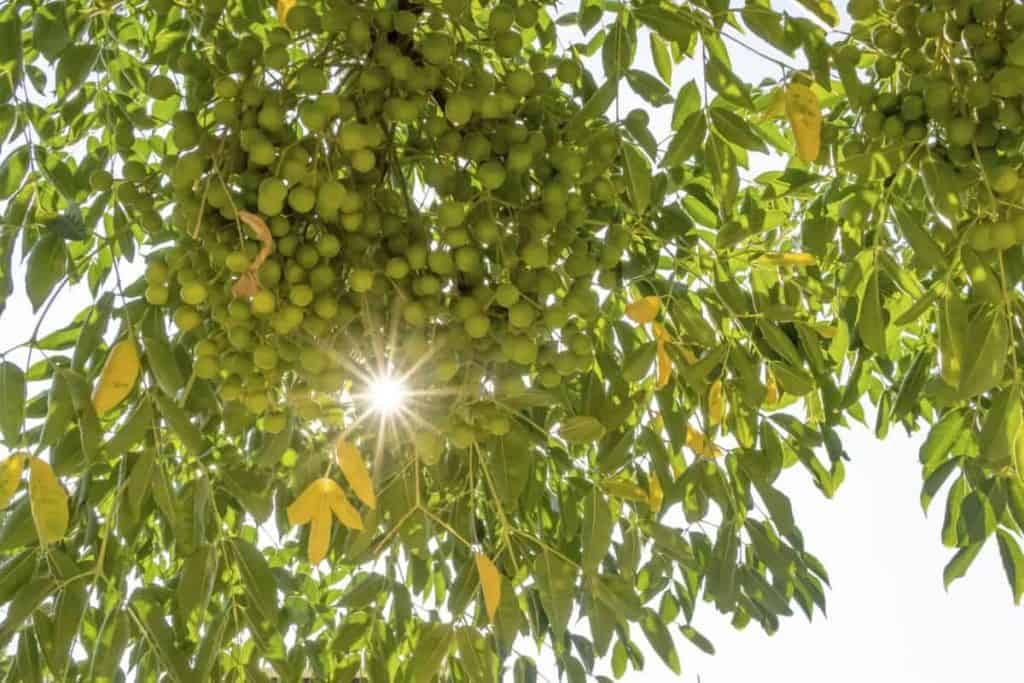
Credit: Yay Images
What are soapberries, exactly?
Just as nature provides many healing herbs and botanicals to heal and to nourish, soap nuts are nature’s version of soap. Soapberries are sometimes called soap nuts or referred to as laundry berries, as they’re a greener version of synthetic detergents.
There are roughly 12 species belonging to the class of soapberry shrubs or trees, relatives of the lychee family. These trees or shrubs grow in many tropical and subtropical regions of Asia, the Americas, and islands of the Pacific.¹
The trees form small white, or pale yellow flowers. Resembling grapes, the fruits start off pale green or orange, and when ripe, turn black. The fruits, when dried, turn hard and leathery, which is why many people mistakenly believe they are nuts, instead of fruits.
The key to the soapberry’s cleaning power lies in its natural saponins. The bulk of its saponins are found in the dried shells.
One of the most common types of this tree is Sapindus mukorossi, also called the Chinese soapberry tree, which is native to many Asian countries including China, India, and Nepal.
There are also some North American varieties, including the Western soapberry tree (Sapindus drummondii) native to Texas.²
Tip: Since soapberries are not truly nuts at all, they are safe for those with nut allergies!
Don’t confuse these two soapberries
Don’t confuse soapberry from the genus Sapindus with the similarly named “soapberry” from the Canada buffaloberry (Shepherdia canadensis) shrub.
Grizzly and black bears feast on these red buffaloberries before hibernation. While buffaloberries are edible, they are very bitter. Local indigenous people use buffaloberries in various food recipes, including ice cream!
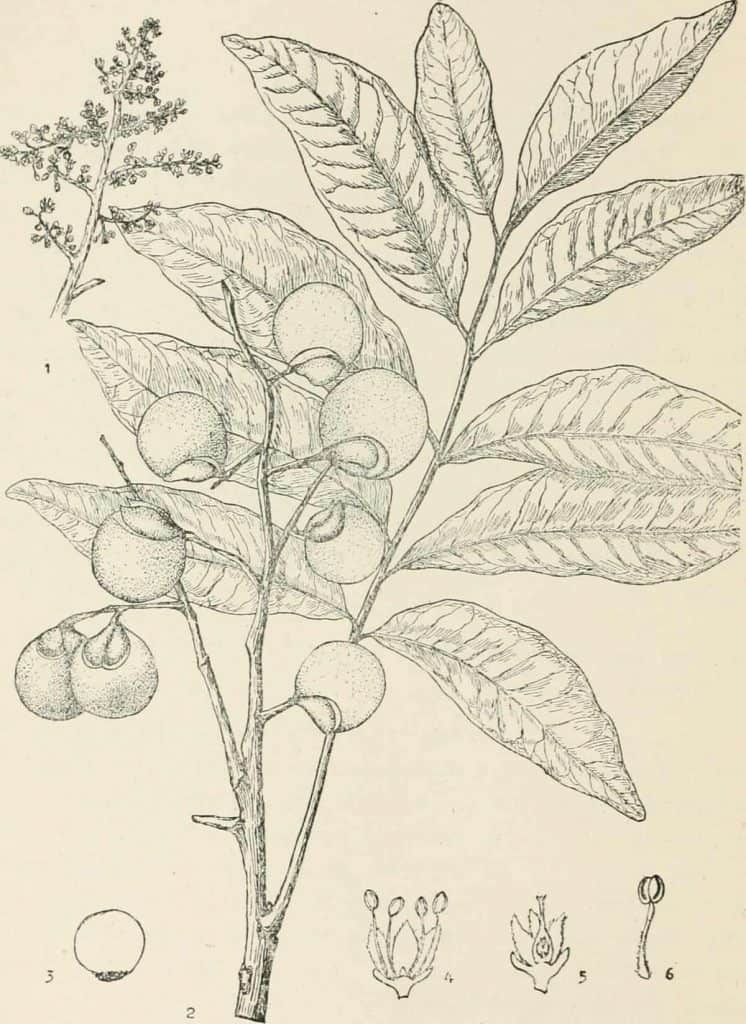
Credit: Flickr / Internet Archive Book Images, Chinese economic trees
A closer look at saponins and surfactants
Saponins are naturally occurring glycosides that can create foam and lather. They are found in many plants including soapberries, broomweed (Gutierrezia sarothrae), cow cockle (Saponaria vaccaria), and most famously, soapwort (Saponaria officinalis). The latin word “sapo” means soap.³
Saponins found in plants such as cow cockle often cause issues for grazing livestock.³
You can also find saponins in many common foods, including alfalfa, oats and spinach.
Soapberries are biosurfactants. A surfactant is any compound which reduces the surface tension of water, allowing oil and dirt particles to more easily wash away.
While surfactants found in chemical detergents such as sodium lauryl sulfate (SLS) or sodium laureth sulfate (SLES) are harsh cleansers, soap nuts are a natural cleaning agent.
Artificial foaming agents like SLS and SLES are often linked to dry, itchy skin. Natural surfactants, on the other hand, are chemical-free and are mild enough for sensitive skin.
Do soapberries actually work?
Yes, this is one natural product that really works! I switched to using these berries for laundry years ago as my daughter has eczema. After I ditched the chemical detergents, I noticed her eczema patches and dry, flaky skin were much better.
But don’t listen to me. To answer the question, are soapberries effective at cleaning, I’ll point you to a study.
A 2011 study investigated the composition of an aqueous solution of soap nuts from the Sapindus mukorossi tree, commonly called ritha.⁴
When soaked in a liquid solution overnight, they found the fruit’s pericarp produced strong surfactant action.
Researchers found the saponin-filled water to be a viable alternative to synthetic surfactants such as sodium dodecyl sulfate (SDS), also known as sodium lauryl sulfate (SLS).
The difference is that soap nuts are natural, and milder on skin, and the environment making it a great natural soap.
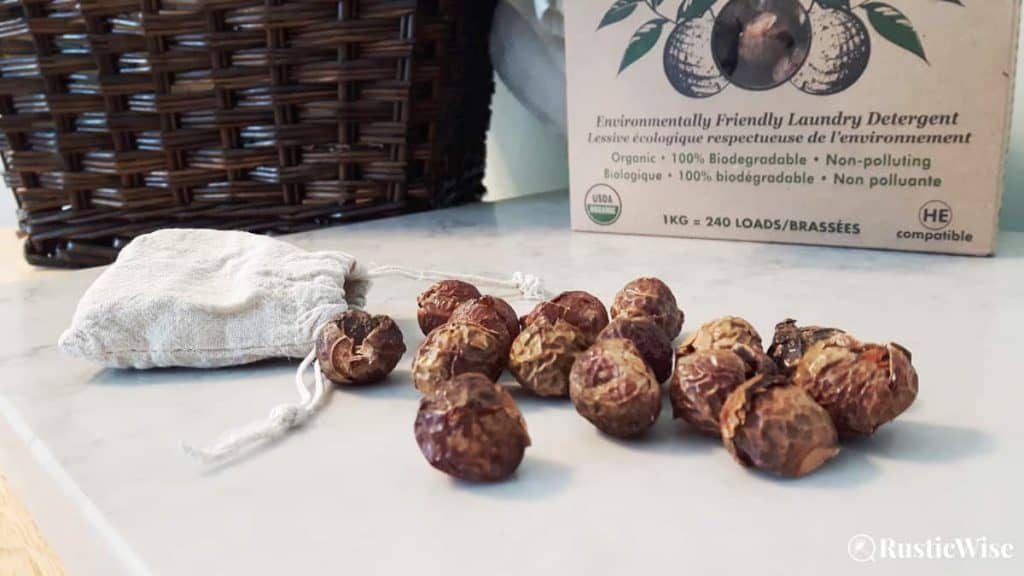
7 Benefits of soap nuts
As a natural detergent, soapberries have plenty of good things going on. Here are some of the top benefits of soap nuts.
- Antimicrobial properties: The antimicrobial properties of soapberries make them an effective cleanser for both household use and personal care. A 2006 animal study examined the properties of powder extracted from S. mukorossi berries to check for their effectiveness against fighting gram-positive and gram-negative bacteria, both in vitro and in vivo. Researchers found infections cleared within a week at low concentrations of the treatment.⁵ Other studies point to other insecticidal, fungicidal, and anti-tumour properties of the fruits from S. mukorossi.⁶
- Chemical-free: This natural product literally grows on trees. I’m not sure how much more natural you can get than that!
- Reusable: You can use each little soap nut more than once. How many uses you can get out of them really depends on the type of water you have at home (hard vs. soft), what you’re washing, etc. When using them for laundry, I usually get between 3 and 5 wash loads out of them.
- Biodegradable and compostable: Once you’re done with them, simply chuck them into your backyard compost pile. They are natural and completely biodegradable. If you don’t have your own compost bin, you can slip them into your organic waste bin for pickup. And unlike liquid conventional detergent which comes in a plastic bottle, most companies sell laundry nuts in eco-friendly packaging such as recyclable cardboard.
- Compatible with high efficiency washers: If you have a HE washing machine at home, these laundry nuts work fine.
- Mild and gentle: Gentle enough for a baby’s skin, soap nuts contain none of the harsh chemicals linked to skin aggravation. Soap nuts are also fragrance-free and dye-free—perfect for those with skin conditions such as eczema, psoriasis, or just sensitive skin.
- Vegan-friendly: Completely plant-based, no animal byproducts.
7 ways to use soapberries for cleaning and personal care
While these natural berries provide cleaning power and lather, don’t expect them to create as much foam as synthetic chemicals. They create a mild lather when mixed with warm water. And, if you’re big on fragrances, you’ll need to add a few drops of your favorite essential oils to your DIY concoctions!
Tip: Remember that once you’ve extracted the saponins into a liquid, it doesn’t last forever. (There are no chemical preservatives, remember?) Use your soapberry liquid within two weeks. You can stick it in the fridge to extend its shelf life. You’ll know it’s time to chuck it once it becomes slimy or smelly!
How to make a multipurpose soapberry cleaning liquid
The key to releasing the natural saponins is to use hot water or warm water to create a concentrated liquid solution.
You can do this in a few different ways:
- Boiling to make a decoction
- Steeping overnight
- Grinding soap nuts into a powder
I will just go over the most common method, boiling. You can check out the other two methods in our article about soap nut shampoo here.
Most soap nut packages come with a small fabric drawstring pouch that fits several soap nuts. You can use this pouch to skip the straining step—easy-peasy! (If you don’t have a pouch, no worries, you can just strain afterwards.)
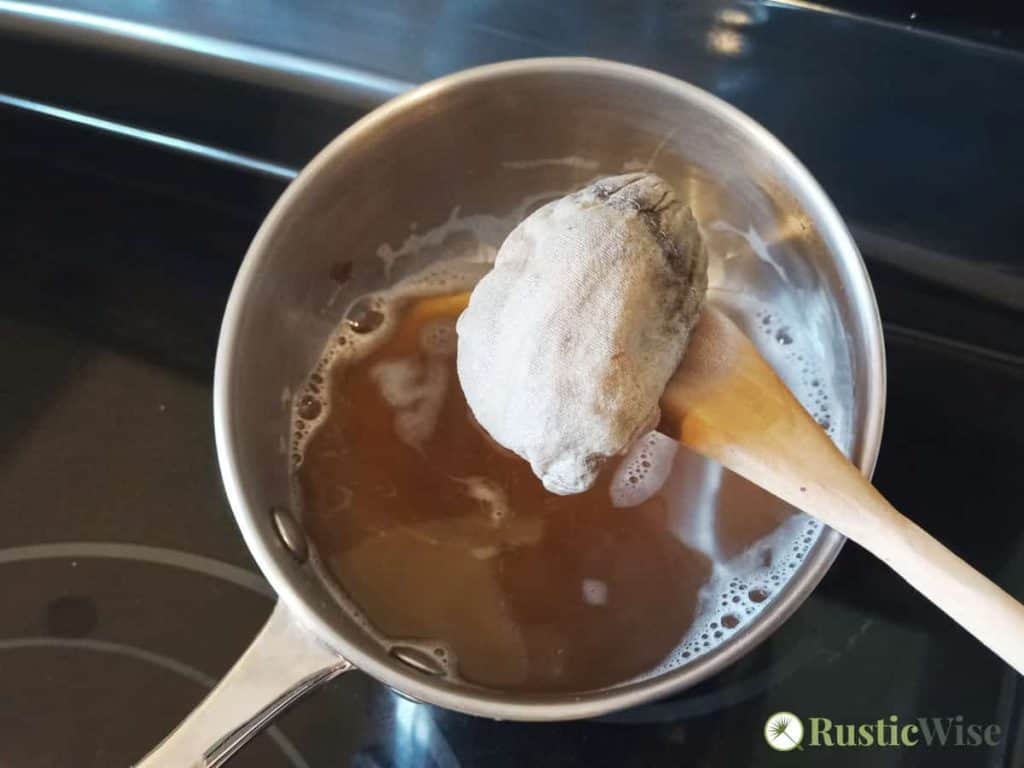
You’ll need:
- Small saucepan
- Small fabric pouch (or sieve if you don’t have a pouch)
- Between 5 to 10 soap nuts (adjust accordingly depending on if your water is hard or soft)
- Wooden spoon
- Roughly 2 1/2 cups water (591 milliliters)
- Fill saucepan with water. Fill the pouch with several soap nuts and place in the water.
- Bring to a boil. Reduce heat to medium-low so the water comes to a rolling boil. Let the soap nuts boil for 10–15 minutes. Periodically use your spoon to stir and press the soapberries to release saponin.
- Carefully remove the pouch with a spoon and place the whole pouch onto a plate to air dry. You can use your soap nuts more than once!
- Remove from heat. Let the liquid solution cool. Store in an air-tight container in the fridge.
So now that we know how to extract the saponins to make a liquid, let’s look at all the ways you can use this liquid around the house!
Tip: Before using a liquid solution, give it a good swirl first!
- Natural laundry soap: I have been using soapberries for years with no issues. The soapberries act as a natural fabric softener too. Just don’t expect your clothes to smell of spring meadows. My freshly laundered clothes have a neutral scent, which is what I like, anyway. Add several soap nuts to a fabric pouch and run a normal wash. While you can use cold water in your washing machine (it just releases the saponins at a slower and lower rate), water at warmer temperatures helps coax saponins from the soapberries.
- Handwashing delicates: For those times when you need to wash your delicates, a good mild soap to use is soapberry liquid. Add the soap nut liquid to a basin filled with warm water and work up some lather by gently rubbing garments together.
- Multi-purpose household cleaner: Add your liquid soapberry to a spray bottle and use where needed. To boost cleaning power and to add some natural scents, you can try adding a few drops of lemon essential oil, lavender oil, or sweet orange oil. This natural cleaning solution is safe on virtually all surfaces: stainless steel, glass, mirrors, countertops, tile and tub. To stay on the safe side, do a small patch test in an inconspicuous area before using.
- Shampoo: Looking for a natural shampoo? Check out our article on making your own soap nut shampoo. Add your liquid to a non-breakable container such as a squeeze bottle when showering. You can add a few EOs such as lavender essential oil, peppermint essential oil, or rosemary essential oil. Avoid getting into eyes as this stuff stings! Follow up with an apple cider vinegar rinse.
- Body wash: Liquid soapberries make for a gentle all-purpose body wash. Apply a generous amount to a washcloth or loofah.
- Hand soap: Add to a liquid soap dispenser and use a natural gentle soap. The antimicrobial properties of soap nuts make this an easy DIY soap.
- Dish soap: Ran out of liquid dish soap? No worries! Apply some soapberry juice onto a dish cloth and wash away.
Is soapberry good for hair?
Soapberry liquid shampoo is mildly acidic, which jives well with the naturally acidic pH level of healthy hair. Acidic hair products help close hair cuticles, making hair shiny and smooth.
If you’re on the lookout for a different natural shampoo, you might like soap nut shampoo.
I use it from time to time on my thick, coarse hair. It doesn’t lather like regular commercial shampoos, but it still gives hair a gentle clean. To finish, I would recommend treating hair to a (diluted) apple cider vinegar rinse.
Do soap nuts smell nice?
So, what do soap nuts smell like?
I would describe the smell of soapberry liquid to have earthy notes, with a hint of berries. It’s an overall mild smell (depending on how concentrated your liquid is). To me, it smells like nature!
Can you eat soap berries?
It’s NOT recommended that you eat soap nuts or soapberries, despite having a very edible-sounding name. This is because of the high levels of saponins present in the fruit. According to Britannica, some fruits may contain up to 37 percent saponin.¹
At the very least, soapberries straight from the tree won’t taste very good. It may have a bitter flavor. If you (or a little one) accidentally ingested a soap nut or two, don’t worry. The human body doesn’t readily absorb saponins—most of it passes through. At worst, you may suffer from some stomach pain or indigestion.⁷ (Please seek medical help if needed!)
Once the berries are soaked or cooked, some traditional Indian dishes feature frothy desserts made with soapberries; a milk-based dessert called rasgullas is an example.
High levels of saponins are very dangerous to certain animals, such as fish. Soapberries are sometimes used to make fish poison.⁷
Are soapberries poisonous to dogs?
Yes, fruits from the soap nut tree (any member of the Sapindus genus) may be poisonous to dogs. The saponins in the fruits are toxic to many animals, including fish and cattle.
But the toxicity of this plant really depends on the level of saponins present in the fruits, how much your dog ate, your dog’s size, etc. Sometimes you’ll find low levels of saponins present in some types of dog food.
If you have a soapberry tree in your yard, keep your pets away from any fallen fruits to stay on the safe side.
How long do soapberries last?
When stored properly in a cool, dry place, unused soap nuts can last indefinitely. Soap nuts can be reused several times. When I’m using them for laundry, I find I use them at least three times. (This really depends on your water hardness and how soiled your laundry is.)
To do a simple test to see if your laundry nuts are good for another go, wet the fabric pouch and gently rub the soapberries. If they produce a soapy lather, they’re still good to use.
Liquid soap nut solutions can last between 1 and 2 weeks. I keep mine in the fridge, but room temperature is also fine. You’ll need to discard it when it turns slimy or smelly!
Where can you buy soap nuts?
You’ll find soapberries at most green, eco-friendly stores, or in the “green” aisle of large grocery stores. You can also find them online on Amazon and suppliers of green home products. I picked up my last batch at a local Bulk Barn store.
Would you like more timeless tips via email?
Fun tips to help you live an independent, self-sustaining lifestyle. Opt-out at any time.


References
- Britannica, Soapberry, https://www.britannica.com/plant/soapberry. Accessed April 2022.
- University of Florida Extension, SAPINDUS DRUMMONDII: WESTERN SOAPBERRY, https://edis.ifas.ufl.edu/publication/ST581. Accessed April 2022.
- Cornell University, Saponins, https://poisonousplants.ansci.cornell.edu/toxicagents/saponin.html. Accessed April 2022.
- Ghagi, R. (2011). Study of functional properties of Sapindus mukorossi as a potential bio-surfactant. Indian Journal of Science and Technology, 4(5), 530–533. https://doi.org/10.17485/ijst/2011/v4i5.8
- Ibrahim, M., Khan, A. A., Tiwari, S. K., Habeeb, M. A., Khaja, M. N., & Habibullah, C. M. (2006). Antimicrobial activity of Sapindus mukorossi and Rheum emodi extracts against H pylori: In vitro and in vivo studies. World journal of gastroenterology, 12(44), 7136–7142. https://doi.org/10.3748/wjg.v12.i44.7136
- Upadhyay, A., & Singh, D. (2012). Pharmacological effects of Sapindus mukorossi. Revista Do Instituto de Medicina Tropical de São Paulo, 54(5), 273–280. https://doi.org/10.1590/s0036-46652012000500007
- Plants For A Futre, Sapindus mukorossi – Gaertn., https://pfaf.org/user/Plant.aspx?LatinName=Sapindus+mukorossi. Accessed April 2022.

Author: Theresa Tesolin
Theresa is co-founder of RusticWise. She helps people unleash their inner DIY spirit by encouraging them to get dirty and make or grow something from scratch.

